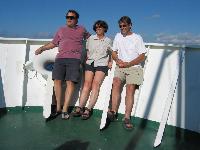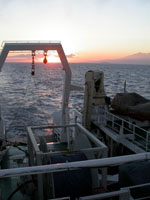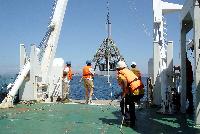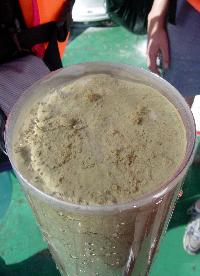Indonesian Throughflow
The Indonesian Throughflow (ITF) refers to the transfer of upper ocean waters from the Pacific to the Indian Ocean through the Indonesian Seas. ITF flow varies seasonally in response to the monsoons, and is also correlated with interannual variations in the Pacific (El Nino/Southern Oscillation). Variations in the ITF affect the properties, and climate of both the Indian and Pacific Oceans, and may also feedback and influence ENSO. It is not known whether the ITF has varied in the past, and if so, the effect of these variations on regional and global climate.
In 2003, we collected sediment cores from the Indonesian Seas in order to reconstruct past changes in the Indonesian Throughflow (ITF) and climate of the region. We collaborated with Indonesian scientists and used the R/V Baruna Jaya VIII, an Indonesian vessel. WHOI's Jim Broda designed a coring rig, capable of taking multicores and gravity cores for the vessel.
As most of the ITF occurs in the thermocline, most of the cores we collected were from thermocline depths. Work in our labs confirms that many of the cores we collected have high accumulation rates (even in excess of 100cm/kyr), and many have modern core-tops. We are using the chemistry of benthic foraminifera in thermocline depth cores to reconstruct changes in the ITF at decadal resolution during the Holocene. We are also using the chemistry of planktonic foraminifera to reconstruct surface hydrography, and by measuring the chemistry of thermocline dwellers, a second measure of thermocline depth and properties.
- Yair Rosenthal (left), Brad Linsley (right) and I towards the end of our cruise on the Baruna Jaya VIII in Indonesian waters.
- Indonesian islands from the Baruna Jaya VIII.
- Mulitcorer being lowered into Indonesian waters. Once allowed to settle gently into the sediments, the clear multicorer tubes fill with sediment. This is the best way to recover the undisturbed recent sediments.
- A filled multicorer tube.
Latest Publications
- Linsley, B. K., Y. Rosenthal, and D. W. Oppo, Holocene evolution of the Indonesian throughflow and the western Pacific warm pool, Nature Geoscience, 3, 578–583, 2010.
- Oppo, D. W., and Y. Rosenthal, The Great Indo-Pacific Communicator (solicited Perspective on the Indonesian Throughflow), Science 328, 1492-1494, 2010.
- Oppo, D.W., Y. Rosenthal, B.K. Linsley, 2000-year-long temperature and hydrology reconstructions from the Indo-Pacific Warm Pool, Nature, 460 113-160, doi:10.1038/nature08233, (2009).
Student Projects
- MIT/WHOI Joint Program student Fern Gibbons is carrying out a core-top calibration of deeper dwellers, and will take the lead on the downcore multiple species planktonic work. Her core-top calibration includes the eastern Indian Ocean, and she is planning to study how variations in ITF have affected the eastern Indian Ocean.
- MIT/WHOI Joint Program student James Saenz is characterizing organic biomarkers in core-top sediment and has generated downcore record for one Holocene core. The records show orbital scale trends. He is currently trying to distinguish between two interpretations for the signals: an interpretation that involves changes in ITF transport of different vegetation types and a local vegetation signal.
- University of NY at Albany student Samantha Logan has generated downcore records in Kau Bay, a silled basin. Her results suggest a correlation between ventilation of the basin and ENSO.
- Brown University student Jessica Tierney generated detailed leaf wax dD records for the late Holocene.
- Macalester College student Allison Jacobel has done a core-top survey of sterols as productivity indicators and will generate a downcore record. Website
Student-Lead Publications
- Tierney, J. E., D. W. Oppo, Y. Rosenthal, J. M. Russell, and B. K. Linsley, Coordinated hydrological regimes in the Indo-Pacific region during the past two millennia, Paleoceanography, 25, PA1102, doi:10.1029/2009PA001871, 2010.
- Langton S.J., Linsley B.K., Robinson R., Rosenthal Y., Oppo D.W., Eglinton T.I., Howe S.S., Djajadihardja Y.S., and F. Syamsudin. 3500 year record of centennial-scale climate variability from the Western Pacific Warm Pool Geology. 36(10): 795–798; doi: 10.1130/G24926A, 2008.
Collaborators
Yair Rosenthal (Rutgers)
Brad Linsley (LDEO)
Mayhar Mohtadi (MARUM, U. Bremen)
Tim Eglinton (ETH)
Fern Gibbons (Former WHOI student)
Several Rutgers students
Related Links
- Allison Jacobel's ITF website
Guest Student Allison Jacobel discusses her summer work on Indonesia sediment



